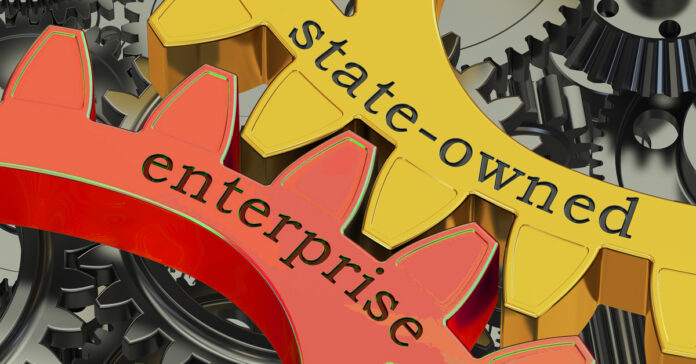The International Monetary Fund (IMF) has expressed concerns about the delay in updating the evaluation of loss-making state-owned enterprises (SOEs) and the release of a report by the end of December.
This is in accordance with the structural benchmark of the IMF’s $3 billion Standby Arrangement (SBA).
The IMF stressed enacting the new SOE law in early 2023, and called for swift progress, with the support from the Asian Development Bank (ADB), on: (i) developing a new ownership policy; (ii) amending several SOE-dedicated Acts (end-November 2023 SB, 12); (iii) advancing the delayed full operationalisation of a CMU within the MoF (end-November 2023 SB, 12); (iv) gradually reducing the footprint of the state (based on the March 2021 SOE Triage and including the divestment of two LNG-based power plants, one development finance institution, and one small public bank); and (v) continuing with regular and timely audits of key SOEs.
What are SOEs?
Pakistan has a total of 212 state-owned entities, 85 out of which are commercial entities. A recent report published by the World Bank has named Pakistan’s SOEs as the worst in Asia.
Since the financial year 2014-15, Pakistan’s SOEs have been in a net loss. Every year, the loss gets higher. As of FY18, Pakistan recorded a cumulative total of Rs286 billion in net losses incurred by SOEs.
It is important to remember that net losses also account for all the SOEs that have made a profit. The projections after 2019 are missing in the report but it is no secret that the net profit of the SOEs of Pakistan is still below 0.
A recent World Bank report revealed that Pakistan’s SOEs eat more than Rs458 billion in public funds annually just to stay afloat and their combined loans and guarantees rose to almost 10 percent of GDP or Rs5.4 trillion in FY21, up from 3.1 percent of GDP (Rs 1.05 trillion) in 2016. The report deems the SOEs of Pakistan as the worst in Asia.
The “State-Owned Enterprises Triage: Reforms & Way Forward” that was initially published by the World Bank and later by the Finance Division in 2021 states that 90% of the losses incurred by the state owned enterprises can be attributed to the top 10 loss making entities.
Hence these “white elephants” is where the problem essentially lies. Logically, these entities would be concentrated on and would be on the priority list for privatization, however, that is not the case. The proposed solution itself, is what the “triage” is all about.
Current situation
According to the Ministry of Finance, a Central Monitoring Unit (CMU) was established in September 2022 to enhance the monitoring and oversight functions of SOEs.
The CMU is expected to become fully operational with the hiring of necessary staff and the publication of its inaugural periodic report on SOEs’ performance, as outlined in Section 31(3) of the new SOEs law, using the latest available data.
Furthermore, a new SOE law came into effect in December 2022, which is designed to ensure that SOE operations are commercially oriented. This law also defines the criteria for categorizing an SOE as commercial and strengthens the oversight and ownership arrangements.
Proposed solutions
The World Bank report highlighted a framework designed to help policymakers make informed decisions about whether to retain, restructure, or divest SOEs based on their strategic importance, financial performance and social impact.
The proposed framework includes the following steps:
- Strategic importance: This step involved assessing the strategic importance of each SOE by analysing its role in the economy, its contribution to public policy objectives, and its potential for private sector competition. SOEs that were deemed to have strategic importance would be retained by the government.
- Financial performance: This step involved analysing the financial performance of each SOE by looking at its profitability, efficiency, and solvency. SOEs that were financially sound would be retained, while those that were financially unsustainable would be divested.
- Social impact: This step involved analysing the social impact of each SOE by assessing its contribution to employment, income distribution, and public service provision. SOEs that had a positive social impact would be retained, while those that had negative social impacts would be restructured or divested.
Based on this model that was devised in 2019, and approved in 2021, the result of assessment has finally made its way to the parliament.
Much to the disappointment of a lot of Pakistanis, most of the top 10 loss making entities have not been made a part of the privatisation list in the first phase.
The Finance Division decided to retain PIA, Pakistan Railways, and Pakistan Post along with most of the DISCOs and GENCOs that are expected to be privatised in the “next phase”. Owing to the ongoing political instability in Pakistan, “next phase” often means a halt for the foreseeable future.





It will be more beneficial and vibrant to get rid of these SOE,S as soon as possible….
We are good “talkers” but not good “workers”. 90 percent of today’s work force believe in making money not by hard work but through other means. This is evident in every field – no State owned enterprise is free from corruption. The time has come, for those running the Country to enforce discipline in our ranks – “the fear of God is the beginning of wisdom”.